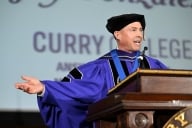You have /5 articles left.
Sign up for a free account or log in.
The one really startling moment in Michael Shermer’s Skeptic: Viewing the World With a Rational Eye (Henry Holt and Company) comes in chapter 38, which begins with a description of his abduction by, presumably, space aliens. This was in 1983, “in the wee hours of the morning, “somewhere along a lonely rural highway approaching Haigler, Nebraska.”
That it took place near Haigler, Neb., is not the surprising part, of course: the extraterrestrials show a definite preference for such locales. Nobody ever gets abducted from the White House lawn. (They must have their reasons.)
But by chapter 38 -- each chapter being a stand-alone essay originally appearing in Shermer’s monthly column for Scientific American -- the author has debunked Atlantis, The Bible Code, Bigfoot and psychic powers, as well as several “alternative medicine” practices now prevalent enough, and in some cases dangerous enough, to make you wonder what the Food and Drug Administration people actually do all day. The polemics against pseudoscience appear alongside explanations and reflections on science, proper. They express the confidence of a rational mind in an intelligible universe -- and that context makes the author’s Nebraska interlude seem doubly odd.
“[A] large craft with bright lights overtook me and forced me to the side of the road. Alien beings exited the craft and abducted me for 90 minutes, after which I found myself back on the road with no memory of what transpired inside the ship. The experience was real and I can prove that it happened because I recounted it to a film crew shortly after, and I am still in contact with some of the aliens.”
Scientific American must have received some strange letters to the editor after that month’s column, I’d imagine, but Shermer’s close encounter can be explained in fairly mundane terms, which we’ll get to in a moment.
Shermer’s willingness to go on the record with the experience distinguishes his essays from the work of the late Martin Gardner, whose 1952 classic Fads and Fallacies in the Name of Science (Dover Publications) and other writings are the obvious point of reference for comparison. Their perspectives on the world have a large margin of overlap, and Gardner would find nothing to argue with when Shermer writes:
“The price to pay for liberty, in addition to eternal vigilance, is eternal patience with the vacuous blather occasionally expressed beneath the shield of free speech. … In a free society skeptics are the watchdogs of irrationalism -- the consumer advocates of bad ideas. Yet debunking is not simply the divestment of bunk; its utility is found in offering a viable alternative, along with a lesson on how thinking goes wrong.”
In another creedal statement, Shermer writes, “What does it mean to have an open mind? It is to find the essential balance between orthodoxy and heresy, between a total commitment to the status quo and the blind pursuit of new ideas, between being open-minded enough to accept radical new ideas and being so open-minded that your brains fall out. Skepticism is about finding that balance.”
For his part, Shermer acknowledges Gardner as a model. He also quotes with approval a point made by the science fiction writer and hard-science popularizer Isaac Asimov: “When people thought the earth was flat, they were wrong. When people thought the earth was spherical, they were wrong. But if you think that thinking the earth is spherical is just as wrong as thinking the earth is flat, then your view is wronger than both of them put together.” (Shermer calls this Asimov’s Axiom.) The irreplaceable and epoch-defining power of scientific research forms the bedrock of each of these figures’ worldviews -- to be defended against relapses into magical thinking as much as possible. Frustrating the effort, if not rendering it completely pointless, is the mass media’s general disinclination to report on real science in any depth while covering the ersatz varieties with all the skill and dedication it can muster.
The situation is not entirely the fault of the executives and producers behind such pseudoreality TV fare as the program about the “controversy” over whether the Apollo moon landings were faked. (You decide!) For part of the problem, as Shermer complains, is that the work of explaining the sciences to a nonspecialist public is typically neglected and even despised by scientists themselves. Carl Sagan and Stephen Jay Gould were notable exceptions, but only at the cost of damage to their professional reputations.
Sagan and Gould are also among the inspirations mentioned in Skeptic, and a number of the essays carry on their work of popularizing the nature and the results of scientific inquiry. But more than a third of the pieces are dedicated to exposing and combating various kinds of quackery, crackpottery, delusions and outright fraud -- a string of updates and supplements to Gardner’s Fads and Fallacies in the Name of Science, in effect. Shermer indicates that he expects to bring out more essay collections in the future, and I greatly hope that when he does, the largest portion of them will be devoted to explaining and interpreting real scientific developments.
For pseudoscience, by contrast, does not develop -- not really. Bad ideas ever appear or disappear, just changing in form. Discrediting claims about lost continents or the mysterious energy of the crystals, unknown to physics, may be a matter of public intellectual hygiene, but at best the reader will learn some basic principles of critical thought (such as “after all this time, it makes sense to talk about the ape man once there’s a corpse to examine; otherwise let’s not”) which are expressed just as well in skeptical writings from years past. Long stretches of Shermer’s book are given over to such exercises in debunkery, and reading them was like watching a man shoot fish in a barrel -- dead fish, at that.
Much more interesting are the essays in which he confronts the factors disposing us to believe weird things. What can make the writing of avowed skeptics frustrating is the tendency to establish a net dichotomy between the reasonable, rigorous, scientific, intelligent people (who don’t succumb to irrational beliefs) and the superstitious, slovenly, harebrained idiots (who do).
That gets boring to read after a while, and, more to the point, it is wrong. For, as Shermer aptly puts it, “smart people believe weird things because they are skilled at defending beliefs they arrived at for nonsmart reasons.” Indeed, cognitive skill and cognitive vulnerability may be linked in inconvenient ways.
“Humans evolved brains that are pattern-recognition machines,” writes Shermer, “designed to detect signals that enhance or threaten survival amid a very noisy world. Also known as association learning (associating A and B as causally connected), we are very good at it, or at least good enough to have survived and passed on the genes for the capacity of association learning. Unfortunately, the system has flaws. Superstitions are false associations -- A appears to be connected to B, but it is not (the baseball player who doesn’t shave and hits a home run). Las Vegas was built on false association learning.” Humans’ unique, language-fostered capacity to create and emit narrative adds another layer of complication and potential trouble: “Like all other animals, we evolved to connect the dots between events in nature to discern meaningful patterns for our survival. Like no other animals, we tell stories about the patterns we find.”
And it is a mark of our success as a species (so far) that we have not had to perfect the skills needed to recognize and break false associations: “The problem is that although true pattern recognition helps us survive, false pattern recognition does not necessarily get us killed, and so the overall phenomenon endured the winnowing process of natural selection.”
Although not explicitly framed as an example, the author’s abduction in Nebraska more than 30 years ago is relevant. Shermer mentions his love of long-distance biking in a number of essays, and in 1983 he was “in the opening days of the 3,100-mile nonstop transcontinental Race Across America,” accompanied by a support crew in a motor home.
After “83 straight hours and 1,259 miles” on his bike, Shermer says, the driver of the motor home flashed its headlights “and pulled alongside while my crew entreated me to take a sleep break.” In a waking dream state, his brain began calling up memories of a science-fiction program he’d watched in childhood: “Suddenly my support team was transmogrified into aliens,” he writes. After 90 minutes of sleep, Shermer found that they had returned to human form, and he then “recounted [the hallucination] to the ABC’s Wide World of Sports television crew” covering the race.
The circumstances were fortunate. He was able to recognize what had happened, to disentangle experience from reality, without trouble or distress. “But at the time the experience was real,” he writes, “and that’s the point. The human capacity for self-delusion is boundless, and the effects of belief are overpowering.” The lesson is better taught by someone who has experienced being overpowered than by someone who thinks of self-delusion as other people’s problem.








